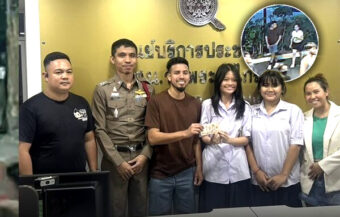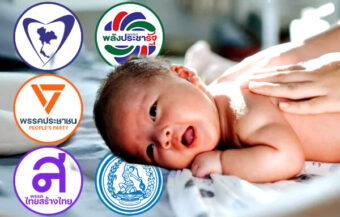Thailand’s tourism sector was hit by declines in Q3 due to a weak economy, flooding, and global tensions. Hopes remain for a recovery in Q4, with a target of 36 million visitors and signs of improvement from Chinese arrivals during the National Day holiday.
Thailand’s foreign tourism is struggling against a negative turn of sentiment in the third quarter, up to the end of September. Data from an industry survey showed performance declined not only from the second quarter but also against the same period in 2023. At the same time, the country finds itself well below the metrics seen before the pandemic in April 2020, when the industry was completely shut down by the government. Nonetheless, the same data collected in the third quarter showed more confidence regarding the final quarter of the year. The kingdom is targeting 36 million visitors and an income of ฿1.81 trillion, some 32% up on last year.

Confidence in Thailand’s tourism sector has plunged during the third quarter of 2024. The tourism confidence index fell significantly year-on-year. It was hindered by sluggish spending, factory closures, unemployment and rising non-performing loans. Additionally, severe flooding in Thailand has taken a toll on domestic tourism activity.
The index, compiled by the Tourism Council of Thailand (TCT), shows the sector is still struggling to recover from the pandemic. In short, Thailand’s economic malaise, as well as international tensions, have combined to prevent a full recovery.
Slight recovery anticipated in the final quarter of 2024 as authorities target 36 million visitors this year
Nonetheless, there are indications from industry future index data that the final quarter of 2024 will be marginally better than 2023. At the same time, Thailand’s economic planners and the Tourism Authority of Thailand (TAT) are targeting up to 36 million visitors for the year.
The TCT met with the board chairman of the Tourism Authority of Thailand (TAT) on Thursday to discuss measures to boost the struggling sector. One key proposal is to increase subsidies for the next phase of the co-payment travel scheme. The current phase provides a 40% subsidy, but the TCT suggests raising this to 50%, focusing on second-tier provinces. The goal is to stimulate domestic tourism.
Chamnan Srisawat, president of the TCT, emphasised the potential return on such a move. For instance, an increase in the copayment travel scheme budget to a minimum of ฿5 billion could generate at least 5 million room bookings.
Tourism confidence index sees a sharp decline as provinces continue to be impacted by severe flooding
He noted that this would encourage local travellers to book three to four room nights on average. However, Chamnan urged the government not to wait until the next low season to implement the scheme, as around 30 provinces have been heavily impacted by recent floods.
The tourism confidence index for the third quarter registered at just 68, well below the pre-pandemic benchmark of 100. This marks a sharp decline from the second quarter’s 79 and a slight drop from the 69 recorded during the same period in 2023. A future tourism index for the fourth quarter showed some improvement, rising to 80, attributed to the approaching high season.
The TCT based its findings on a survey conducted between August 10 and September 15, involving 740 local operators. The sluggish economy, exacerbated by inflation, severe flooding, and international conflicts in the Middle East and Ukraine, has weighed heavily on the tourism sector, Chamnan explained.
Sharp year-on-year declines in tourism revenue and income highlight continued struggles post-pandemic
The data for the third quarter is particularly bleak. The index showed a sharp decline year-on-year, except for Bangkok, eastern, and southern provinces.
Significantly, tourism operators are only reporting 47% of pre-pandemic revenue. The catastrophic impact of the country’s closure to foreign tourism from 2020 to 2022 is still being severely felt.
At the same time, no fewer than 82% of tourism operators are reporting lower income when compared with 2019. Notably, this figure was up from the 54% recorded in 2023. In short, there are worrying signs of a deterioration in conditions within the industry from last year.
Indeed, Mr. Chamnan made that clear. “I’m more worried about an uneven tourism recovery across the supply side,” he explained.
The employment rate reportedly is only 84% of that seen in 2019. In turn, this has declined from 99% in the second quarter.
Global factors, including the strong baht and inflation, compound domestic challenges facing Thailand’s tourism
In addition to domestic challenges, global factors such as ongoing wars and the strong baht have compounded issues for Thailand’s tourism industry. The appreciation of the baht, particularly against the Chinese yuan, has created difficulties for both exporters and the tourism sector. While high-quality Chinese tourists are less affected, middle-income visitors may cut back on spending due to higher prices.
The government’s ฿10,000 handout to vulnerable groups may provide a temporary economic boost. However, Chamnan warned that this will not be enough to sustain a long-term recovery.
Seasonal factors contributed to the third-quarter employment decline. For instance, many workers returned to their hometowns for the harvest season. Flooding in September further worsened the situation for hotels, which reported an average occupancy rate of 54% in the third quarter. Larger international hotels fared better, exceeding the industry’s average.
Yuan depreciation impacts foreign tourist spending as Thailand sees a slight recovery in Chinese arrivals
The appreciation of the baht, especially against the yuan, is another critical factor affecting the tourism industry. Thapanee Kiatphaibool, governor of the TAT, highlighted that the yuan’s depreciation, driven by China’s economic slowdown, has resulted in the baht appreciating by 3.8% since the start of 2024. This has impacted Thai exports, particularly agricultural products, and increased costs for foreign tourists. While high-end Chinese tourists remain relatively unaffected, middle-income travellers may feel the pinch due to the stronger baht.
Despite the challenges, there were some positive signs during China’s National Day holiday period from October 1-7. The TAT suggests a 30% increase in Chinese tourists to Thailand during the holiday, with an average of 18,000 arrivals per day. Direct flights between China and Thailand have also increased by 70% compared to 2023, contributing to a 250% rise in ticket bookings from China for this period.
In short, the number of Chinese tourists travelling abroad has recovered to 85% of 2019 levels, and the high demand for trips to Thailand reflects the country’s continued appeal.
Despite some growth, Thailand’s target of 35.9 million visitors in 2024 remains a challenging goal to reach
However, nothing can be taken for granted. Up to August 31st, the country received 23.56 million visitors. Its official target is 35.9 million, with an income projected at ฿1.812 trillion. This would represent a 32% increase on last year, but it remains a tall order with foreign tourist arrivals still below 2019 levels. In addition, spend per tourist is significantly lower.
A key factor for the industry has been airline seating capacity. This year, there will be seat capacity for 46 million flights, 82% of what was seen in 2019.
Significantly, Thailand’s most successful month for foreign tourism in its history was December 2019, welcoming 3.93 million foreign tourists. Months later, in April 2020, the country recorded zero foreign tourists, according to Ministry of Tourism and Sports data.
In the meantime, the foreign tourism market has changed substantially. Up to August 31st, the top markets for tourists visiting Thailand are China (2.03 million), Malaysia (1.83 million), India (707,000), South Korea (740,000), and Russia (698,000), among others.
Thailand is presently extremely dependent on the sector for its economy, which is in decline elsewhere. This dependency tends to make policymakers less decisive in taking new initiatives, such as the new tourist tax and insurance proposal promised by the newly installed Minister of Tourism and Sports, Surawong Thienthong.
New Electronic Travel Authorisation (ETA) system coming soon with a ฿300 tourist levy and insurance
Thai Airways to refloat on Stock Exchange in June 2025 with a renewed mission as national carrier
There are also signs of potential positive developments, such as Thai Airways’ plan to refloat on the Stock Exchange in June 2025. The national airline plans to make Bangkok its flight hub and expand its flights to and from the country.
Join the Thai News forum, follow Thai Examiner on Facebook here
Receive all our stories as they come out on Telegram here
Follow Thai Examiner here
Further reading:
New Electronic Travel Authorisation (ETA) system coming soon with a ฿300 tourist levy and insurance
Tragic death of a Taiwanese tourist is another wake-up call for the government on insurance cover
66-year-old Thai woman highlights Thailand’s official tiered pricing in hospitals for foreigners
Negative reaction and horror at Thailand’s plan to charge foreigners more than locals at hotels


















